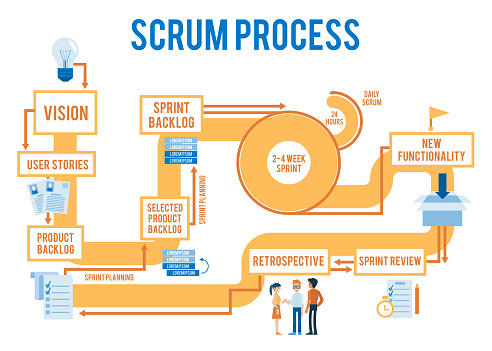At this time, we will talk about one of software development method: Scrum.
What is Scrum?
Scrum is a framework for dealing with complex issues. A guide for those who want to adapt quickly to the changing times, especially when it comes to solving problems, creating programs, creating services, finding solutions rapidly, creatively, and innovatively.
Stages of the Scrum Method
In the Scrum process, there are several main stages to know. Scrum Methodology is a method of project management in the development of a product. Essential steps in the Scrum method:
1.Product Owner records all requests for its products according to its priority.
2.Scrum Team chooses one of the jobs or items from the Product Owner priority list. In this stage, the Scrum Team analyzes, explores, and plans their workflow in completing this work.
3.Scrum teamwork, according to methods, fields, and requests that have been mutually agreed
4.Scrum Master ensures the entire Scrum team works according to the original plan.
5.At the end of the time provided (sprint) or when the Developer Team has completed the work, must deliver the work.
6.Review scrum teamwork (product review).
7.The project is considered complete. Either because the product’s quality has been on-demand or because the work is already at the specified time limit.
Benefits of SCRUM
Benefits for the Company
Firstly, The Company can focus on the efforts required to develop prioritized user stories and thus reduce overhead and rework. Due to Scrum’s specific benefits to customers, improved efficiency of the development team, customer satisfaction, and therefore customer retention and customer reference will become possible. SCRUM increases the market potential of the Company.
Benefits for Product Manager
Secondly, The Product Manager plays the role of the Product Owner in this project. The responsibility of the product owner is to ensure customer satisfaction. Since Scrum facilitates quick responses, work priorities, absorbing changes, product managers can easily ensure that the work suits the customer’s needs, which in turn provides customer satisfaction.
Benefits for Project Manager
Thirdly, The Project Manager plays the role of the Scrum Master in this project. Then, The nature of Scrum collaboration facilitates easy and concrete planning and tracking. The use of Burndown Charts to understand the remaining work and the Daily Scrum meeting gave the project manager awareness of the project’s current state. This awareness is essential for monitoring projects and for capturing and addressing problems quickly.
Benefits for Development Team
Last but not least, Due to the fast nature of sprints and product delivery at the end of each sprint, development teams are excited to see that they will use their work. Built-in teamwork makes teams enjoy the work they do. Since user stories for each sprint are based on user stories, the team also understands that their work is appreciated.
That’s all about Software Development: SCRUM.
Also read: AGILE
Contact Us
We provide software services for your bussiness.












